ACCM4300 Financial Accounting & Reporting 2: Consolidation Aspects
VerifiedAdded on 2023/06/07
|13
|1586
|223
Report
AI Summary
This report discusses the consolidation of financial statements, focusing on intra-group transactions and the accounting treatment of foreign subsidiaries, particularly within the context of TPG Telecom. It highlights the importance of eliminating intra-group balances to accurately reflect the group's financial position and addresses potential discrepancies arising from differences in reporting dates or unrealized profits. The report also examines the application of IAS 21 in translating foreign currency financial statements into the presentation currency (Australian Dollar) for consolidation purposes, emphasizing the use of appropriate exchange rates for assets, liabilities, income, and expenses. Furthermore, it briefly touches on events occurring after the balance sheet date, such as dividend declarations and revised debt financing agreements. Desklib offers a variety of resources, including solved assignments and past papers, to support students in their academic endeavors.

MASTERS IN FIANANCE
MASTERS IN FIANANCE
1 | P a g e
MASTERS IN FIANANCE
1 | P a g e
Paraphrase This Document
Need a fresh take? Get an instant paraphrase of this document with our AI Paraphraser

MASTERS IN FIANANCE
Table of Contents
BRIEF:....................................................................................................................................................3
ASPECTS OF CONSOLIDATION:..............................................................................................................3
PRESENTATION:.....................................................................................................................................5
REFERENCES:.........................................................................................................................................6
2 | P a g e
Table of Contents
BRIEF:....................................................................................................................................................3
ASPECTS OF CONSOLIDATION:..............................................................................................................3
PRESENTATION:.....................................................................................................................................5
REFERENCES:.........................................................................................................................................6
2 | P a g e
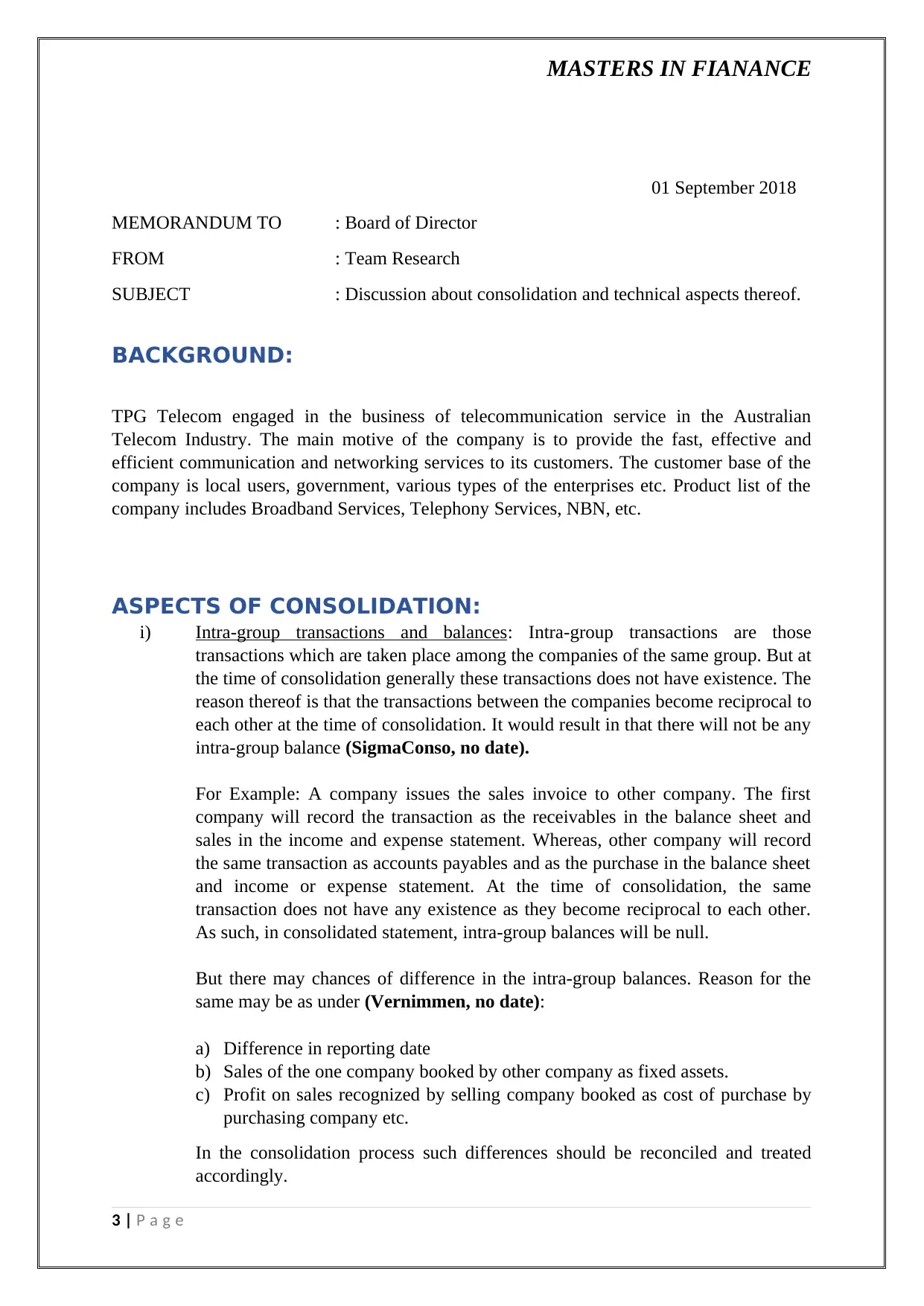
MASTERS IN FIANANCE
01 September 2018
MEMORANDUM TO : Board of Director
FROM : Team Research
SUBJECT : Discussion about consolidation and technical aspects thereof.
BACKGROUND:
TPG Telecom engaged in the business of telecommunication service in the Australian
Telecom Industry. The main motive of the company is to provide the fast, effective and
efficient communication and networking services to its customers. The customer base of the
company is local users, government, various types of the enterprises etc. Product list of the
company includes Broadband Services, Telephony Services, NBN, etc.
ASPECTS OF CONSOLIDATION:
i) Intra-group transactions and balances: Intra-group transactions are those
transactions which are taken place among the companies of the same group. But at
the time of consolidation generally these transactions does not have existence. The
reason thereof is that the transactions between the companies become reciprocal to
each other at the time of consolidation. It would result in that there will not be any
intra-group balance (SigmaConso, no date).
For Example: A company issues the sales invoice to other company. The first
company will record the transaction as the receivables in the balance sheet and
sales in the income and expense statement. Whereas, other company will record
the same transaction as accounts payables and as the purchase in the balance sheet
and income or expense statement. At the time of consolidation, the same
transaction does not have any existence as they become reciprocal to each other.
As such, in consolidated statement, intra-group balances will be null.
But there may chances of difference in the intra-group balances. Reason for the
same may be as under (Vernimmen, no date):
a) Difference in reporting date
b) Sales of the one company booked by other company as fixed assets.
c) Profit on sales recognized by selling company booked as cost of purchase by
purchasing company etc.
In the consolidation process such differences should be reconciled and treated
accordingly.
3 | P a g e
01 September 2018
MEMORANDUM TO : Board of Director
FROM : Team Research
SUBJECT : Discussion about consolidation and technical aspects thereof.
BACKGROUND:
TPG Telecom engaged in the business of telecommunication service in the Australian
Telecom Industry. The main motive of the company is to provide the fast, effective and
efficient communication and networking services to its customers. The customer base of the
company is local users, government, various types of the enterprises etc. Product list of the
company includes Broadband Services, Telephony Services, NBN, etc.
ASPECTS OF CONSOLIDATION:
i) Intra-group transactions and balances: Intra-group transactions are those
transactions which are taken place among the companies of the same group. But at
the time of consolidation generally these transactions does not have existence. The
reason thereof is that the transactions between the companies become reciprocal to
each other at the time of consolidation. It would result in that there will not be any
intra-group balance (SigmaConso, no date).
For Example: A company issues the sales invoice to other company. The first
company will record the transaction as the receivables in the balance sheet and
sales in the income and expense statement. Whereas, other company will record
the same transaction as accounts payables and as the purchase in the balance sheet
and income or expense statement. At the time of consolidation, the same
transaction does not have any existence as they become reciprocal to each other.
As such, in consolidated statement, intra-group balances will be null.
But there may chances of difference in the intra-group balances. Reason for the
same may be as under (Vernimmen, no date):
a) Difference in reporting date
b) Sales of the one company booked by other company as fixed assets.
c) Profit on sales recognized by selling company booked as cost of purchase by
purchasing company etc.
In the consolidation process such differences should be reconciled and treated
accordingly.
3 | P a g e
⊘ This is a preview!⊘
Do you want full access?
Subscribe today to unlock all pages.

Trusted by 1+ million students worldwide
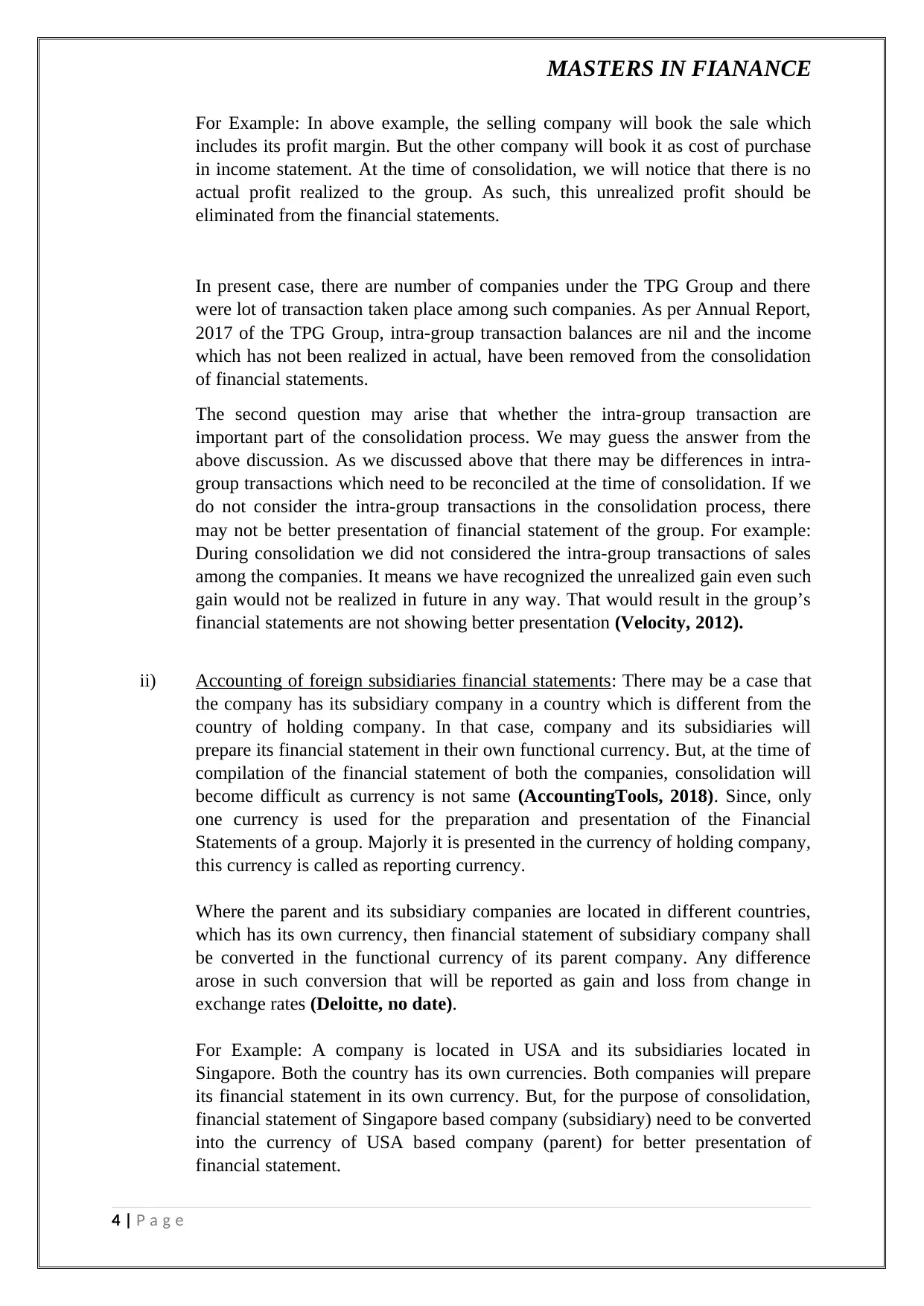
MASTERS IN FIANANCE
For Example: In above example, the selling company will book the sale which
includes its profit margin. But the other company will book it as cost of purchase
in income statement. At the time of consolidation, we will notice that there is no
actual profit realized to the group. As such, this unrealized profit should be
eliminated from the financial statements.
In present case, there are number of companies under the TPG Group and there
were lot of transaction taken place among such companies. As per Annual Report,
2017 of the TPG Group, intra-group transaction balances are nil and the income
which has not been realized in actual, have been removed from the consolidation
of financial statements.
The second question may arise that whether the intra-group transaction are
important part of the consolidation process. We may guess the answer from the
above discussion. As we discussed above that there may be differences in intra-
group transactions which need to be reconciled at the time of consolidation. If we
do not consider the intra-group transactions in the consolidation process, there
may not be better presentation of financial statement of the group. For example:
During consolidation we did not considered the intra-group transactions of sales
among the companies. It means we have recognized the unrealized gain even such
gain would not be realized in future in any way. That would result in the group’s
financial statements are not showing better presentation (Velocity, 2012).
ii) Accounting of foreign subsidiaries financial statements: There may be a case that
the company has its subsidiary company in a country which is different from the
country of holding company. In that case, company and its subsidiaries will
prepare its financial statement in their own functional currency. But, at the time of
compilation of the financial statement of both the companies, consolidation will
become difficult as currency is not same (AccountingTools, 2018). Since, only
one currency is used for the preparation and presentation of the Financial
Statements of a group. Majorly it is presented in the currency of holding company,
this currency is called as reporting currency.
Where the parent and its subsidiary companies are located in different countries,
which has its own currency, then financial statement of subsidiary company shall
be converted in the functional currency of its parent company. Any difference
arose in such conversion that will be reported as gain and loss from change in
exchange rates (Deloitte, no date).
For Example: A company is located in USA and its subsidiaries located in
Singapore. Both the country has its own currencies. Both companies will prepare
its financial statement in its own currency. But, for the purpose of consolidation,
financial statement of Singapore based company (subsidiary) need to be converted
into the currency of USA based company (parent) for better presentation of
financial statement.
4 | P a g e
For Example: In above example, the selling company will book the sale which
includes its profit margin. But the other company will book it as cost of purchase
in income statement. At the time of consolidation, we will notice that there is no
actual profit realized to the group. As such, this unrealized profit should be
eliminated from the financial statements.
In present case, there are number of companies under the TPG Group and there
were lot of transaction taken place among such companies. As per Annual Report,
2017 of the TPG Group, intra-group transaction balances are nil and the income
which has not been realized in actual, have been removed from the consolidation
of financial statements.
The second question may arise that whether the intra-group transaction are
important part of the consolidation process. We may guess the answer from the
above discussion. As we discussed above that there may be differences in intra-
group transactions which need to be reconciled at the time of consolidation. If we
do not consider the intra-group transactions in the consolidation process, there
may not be better presentation of financial statement of the group. For example:
During consolidation we did not considered the intra-group transactions of sales
among the companies. It means we have recognized the unrealized gain even such
gain would not be realized in future in any way. That would result in the group’s
financial statements are not showing better presentation (Velocity, 2012).
ii) Accounting of foreign subsidiaries financial statements: There may be a case that
the company has its subsidiary company in a country which is different from the
country of holding company. In that case, company and its subsidiaries will
prepare its financial statement in their own functional currency. But, at the time of
compilation of the financial statement of both the companies, consolidation will
become difficult as currency is not same (AccountingTools, 2018). Since, only
one currency is used for the preparation and presentation of the Financial
Statements of a group. Majorly it is presented in the currency of holding company,
this currency is called as reporting currency.
Where the parent and its subsidiary companies are located in different countries,
which has its own currency, then financial statement of subsidiary company shall
be converted in the functional currency of its parent company. Any difference
arose in such conversion that will be reported as gain and loss from change in
exchange rates (Deloitte, no date).
For Example: A company is located in USA and its subsidiaries located in
Singapore. Both the country has its own currencies. Both companies will prepare
its financial statement in its own currency. But, for the purpose of consolidation,
financial statement of Singapore based company (subsidiary) need to be converted
into the currency of USA based company (parent) for better presentation of
financial statement.
4 | P a g e
Paraphrase This Document
Need a fresh take? Get an instant paraphrase of this document with our AI Paraphraser
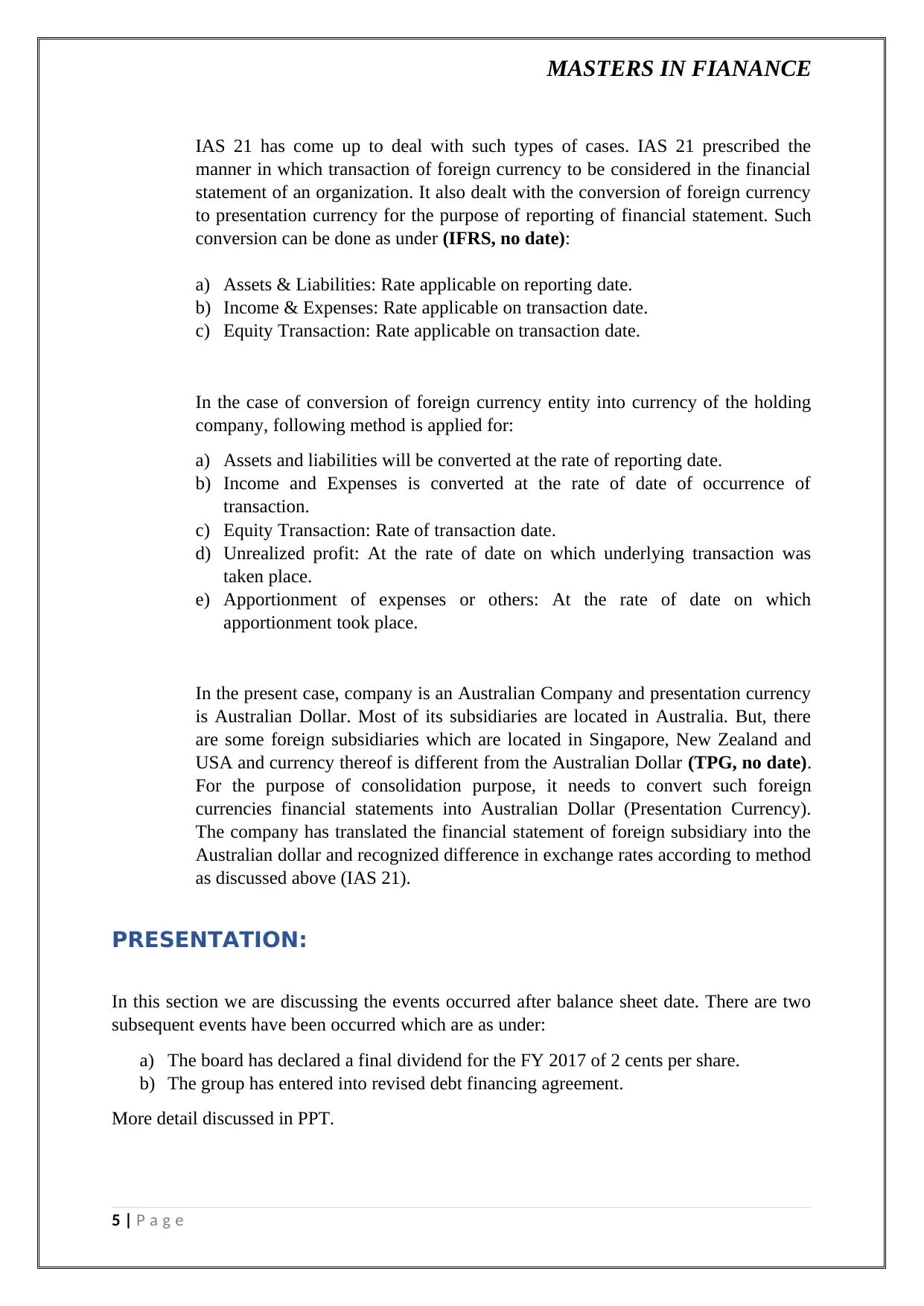
MASTERS IN FIANANCE
IAS 21 has come up to deal with such types of cases. IAS 21 prescribed the
manner in which transaction of foreign currency to be considered in the financial
statement of an organization. It also dealt with the conversion of foreign currency
to presentation currency for the purpose of reporting of financial statement. Such
conversion can be done as under (IFRS, no date):
a) Assets & Liabilities: Rate applicable on reporting date.
b) Income & Expenses: Rate applicable on transaction date.
c) Equity Transaction: Rate applicable on transaction date.
In the case of conversion of foreign currency entity into currency of the holding
company, following method is applied for:
a) Assets and liabilities will be converted at the rate of reporting date.
b) Income and Expenses is converted at the rate of date of occurrence of
transaction.
c) Equity Transaction: Rate of transaction date.
d) Unrealized profit: At the rate of date on which underlying transaction was
taken place.
e) Apportionment of expenses or others: At the rate of date on which
apportionment took place.
In the present case, company is an Australian Company and presentation currency
is Australian Dollar. Most of its subsidiaries are located in Australia. But, there
are some foreign subsidiaries which are located in Singapore, New Zealand and
USA and currency thereof is different from the Australian Dollar (TPG, no date).
For the purpose of consolidation purpose, it needs to convert such foreign
currencies financial statements into Australian Dollar (Presentation Currency).
The company has translated the financial statement of foreign subsidiary into the
Australian dollar and recognized difference in exchange rates according to method
as discussed above (IAS 21).
PRESENTATION:
In this section we are discussing the events occurred after balance sheet date. There are two
subsequent events have been occurred which are as under:
a) The board has declared a final dividend for the FY 2017 of 2 cents per share.
b) The group has entered into revised debt financing agreement.
More detail discussed in PPT.
5 | P a g e
IAS 21 has come up to deal with such types of cases. IAS 21 prescribed the
manner in which transaction of foreign currency to be considered in the financial
statement of an organization. It also dealt with the conversion of foreign currency
to presentation currency for the purpose of reporting of financial statement. Such
conversion can be done as under (IFRS, no date):
a) Assets & Liabilities: Rate applicable on reporting date.
b) Income & Expenses: Rate applicable on transaction date.
c) Equity Transaction: Rate applicable on transaction date.
In the case of conversion of foreign currency entity into currency of the holding
company, following method is applied for:
a) Assets and liabilities will be converted at the rate of reporting date.
b) Income and Expenses is converted at the rate of date of occurrence of
transaction.
c) Equity Transaction: Rate of transaction date.
d) Unrealized profit: At the rate of date on which underlying transaction was
taken place.
e) Apportionment of expenses or others: At the rate of date on which
apportionment took place.
In the present case, company is an Australian Company and presentation currency
is Australian Dollar. Most of its subsidiaries are located in Australia. But, there
are some foreign subsidiaries which are located in Singapore, New Zealand and
USA and currency thereof is different from the Australian Dollar (TPG, no date).
For the purpose of consolidation purpose, it needs to convert such foreign
currencies financial statements into Australian Dollar (Presentation Currency).
The company has translated the financial statement of foreign subsidiary into the
Australian dollar and recognized difference in exchange rates according to method
as discussed above (IAS 21).
PRESENTATION:
In this section we are discussing the events occurred after balance sheet date. There are two
subsequent events have been occurred which are as under:
a) The board has declared a final dividend for the FY 2017 of 2 cents per share.
b) The group has entered into revised debt financing agreement.
More detail discussed in PPT.
5 | P a g e
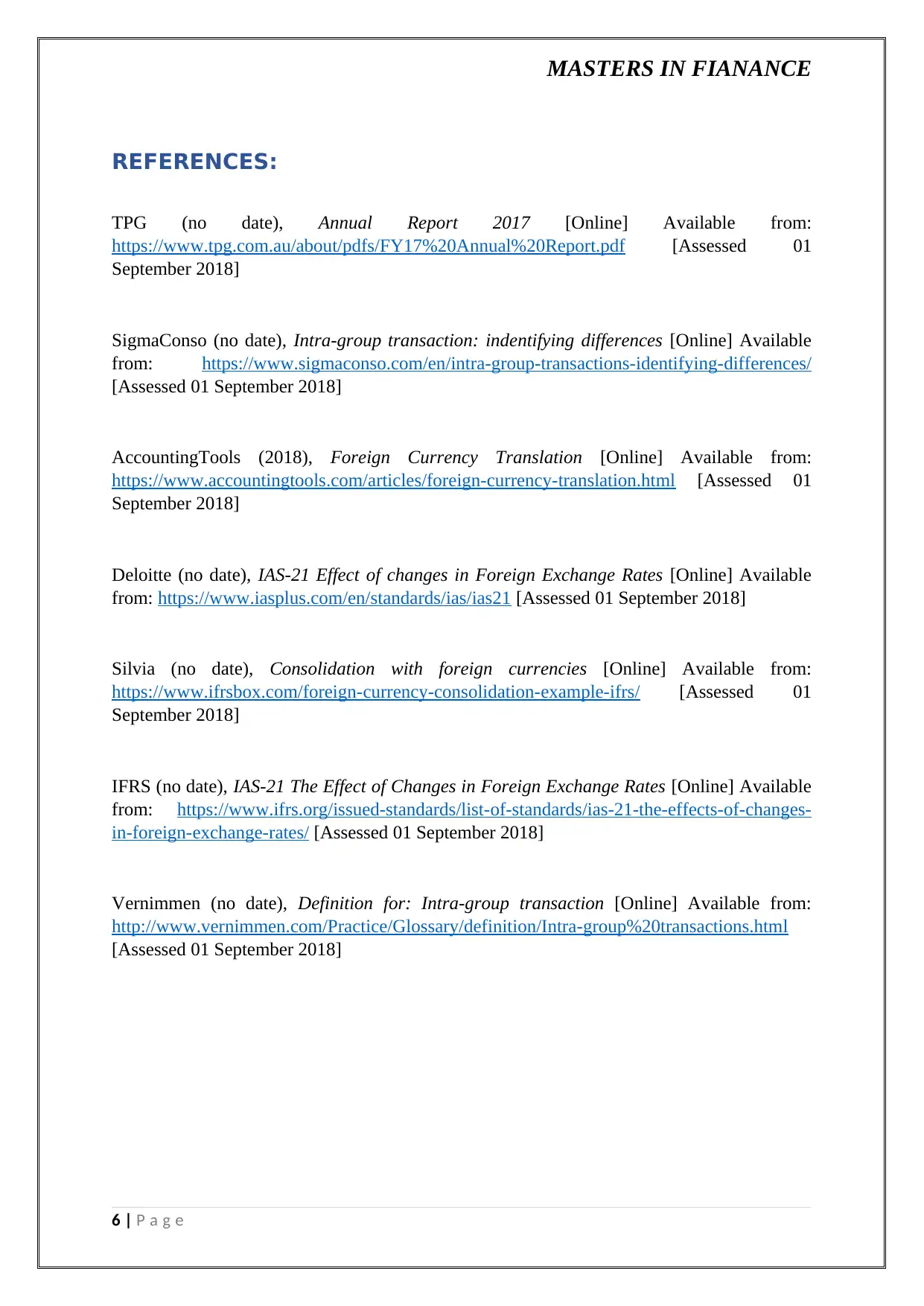
MASTERS IN FIANANCE
REFERENCES:
TPG (no date), Annual Report 2017 [Online] Available from:
https://www.tpg.com.au/about/pdfs/FY17%20Annual%20Report.pdf [Assessed 01
September 2018]
SigmaConso (no date), Intra-group transaction: indentifying differences [Online] Available
from: https://www.sigmaconso.com/en/intra-group-transactions-identifying-differences/
[Assessed 01 September 2018]
AccountingTools (2018), Foreign Currency Translation [Online] Available from:
https://www.accountingtools.com/articles/foreign-currency-translation.html [Assessed 01
September 2018]
Deloitte (no date), IAS-21 Effect of changes in Foreign Exchange Rates [Online] Available
from: https://www.iasplus.com/en/standards/ias/ias21 [Assessed 01 September 2018]
Silvia (no date), Consolidation with foreign currencies [Online] Available from:
https://www.ifrsbox.com/foreign-currency-consolidation-example-ifrs/ [Assessed 01
September 2018]
IFRS (no date), IAS-21 The Effect of Changes in Foreign Exchange Rates [Online] Available
from: https://www.ifrs.org/issued-standards/list-of-standards/ias-21-the-effects-of-changes-
in-foreign-exchange-rates/ [Assessed 01 September 2018]
Vernimmen (no date), Definition for: Intra-group transaction [Online] Available from:
http://www.vernimmen.com/Practice/Glossary/definition/Intra-group%20transactions.html
[Assessed 01 September 2018]
6 | P a g e
REFERENCES:
TPG (no date), Annual Report 2017 [Online] Available from:
https://www.tpg.com.au/about/pdfs/FY17%20Annual%20Report.pdf [Assessed 01
September 2018]
SigmaConso (no date), Intra-group transaction: indentifying differences [Online] Available
from: https://www.sigmaconso.com/en/intra-group-transactions-identifying-differences/
[Assessed 01 September 2018]
AccountingTools (2018), Foreign Currency Translation [Online] Available from:
https://www.accountingtools.com/articles/foreign-currency-translation.html [Assessed 01
September 2018]
Deloitte (no date), IAS-21 Effect of changes in Foreign Exchange Rates [Online] Available
from: https://www.iasplus.com/en/standards/ias/ias21 [Assessed 01 September 2018]
Silvia (no date), Consolidation with foreign currencies [Online] Available from:
https://www.ifrsbox.com/foreign-currency-consolidation-example-ifrs/ [Assessed 01
September 2018]
IFRS (no date), IAS-21 The Effect of Changes in Foreign Exchange Rates [Online] Available
from: https://www.ifrs.org/issued-standards/list-of-standards/ias-21-the-effects-of-changes-
in-foreign-exchange-rates/ [Assessed 01 September 2018]
Vernimmen (no date), Definition for: Intra-group transaction [Online] Available from:
http://www.vernimmen.com/Practice/Glossary/definition/Intra-group%20transactions.html
[Assessed 01 September 2018]
6 | P a g e
⊘ This is a preview!⊘
Do you want full access?
Subscribe today to unlock all pages.

Trusted by 1+ million students worldwide

MASTERS IN FIANANCE
Velocity (2012), Intra-group Transaction [Online] Available from:
http://www.cimaglobal.com/Pages-that-we-will-need-to-bring-back/velocity-archive/
Velocity-e-magazine/Velocity-2012/Velocity-December-2012/F1-Cathy-Sibley-on-intra-
group-transactions-/ [Assessed 01 September 2018]
CONCUR:
Team Research
7 | P a g e
Velocity (2012), Intra-group Transaction [Online] Available from:
http://www.cimaglobal.com/Pages-that-we-will-need-to-bring-back/velocity-archive/
Velocity-e-magazine/Velocity-2012/Velocity-December-2012/F1-Cathy-Sibley-on-intra-
group-transactions-/ [Assessed 01 September 2018]
CONCUR:
Team Research
7 | P a g e
Paraphrase This Document
Need a fresh take? Get an instant paraphrase of this document with our AI Paraphraser

MASTERS IN FIANANCE
APPENDIX:
8 | P a g e
APPENDIX:
8 | P a g e
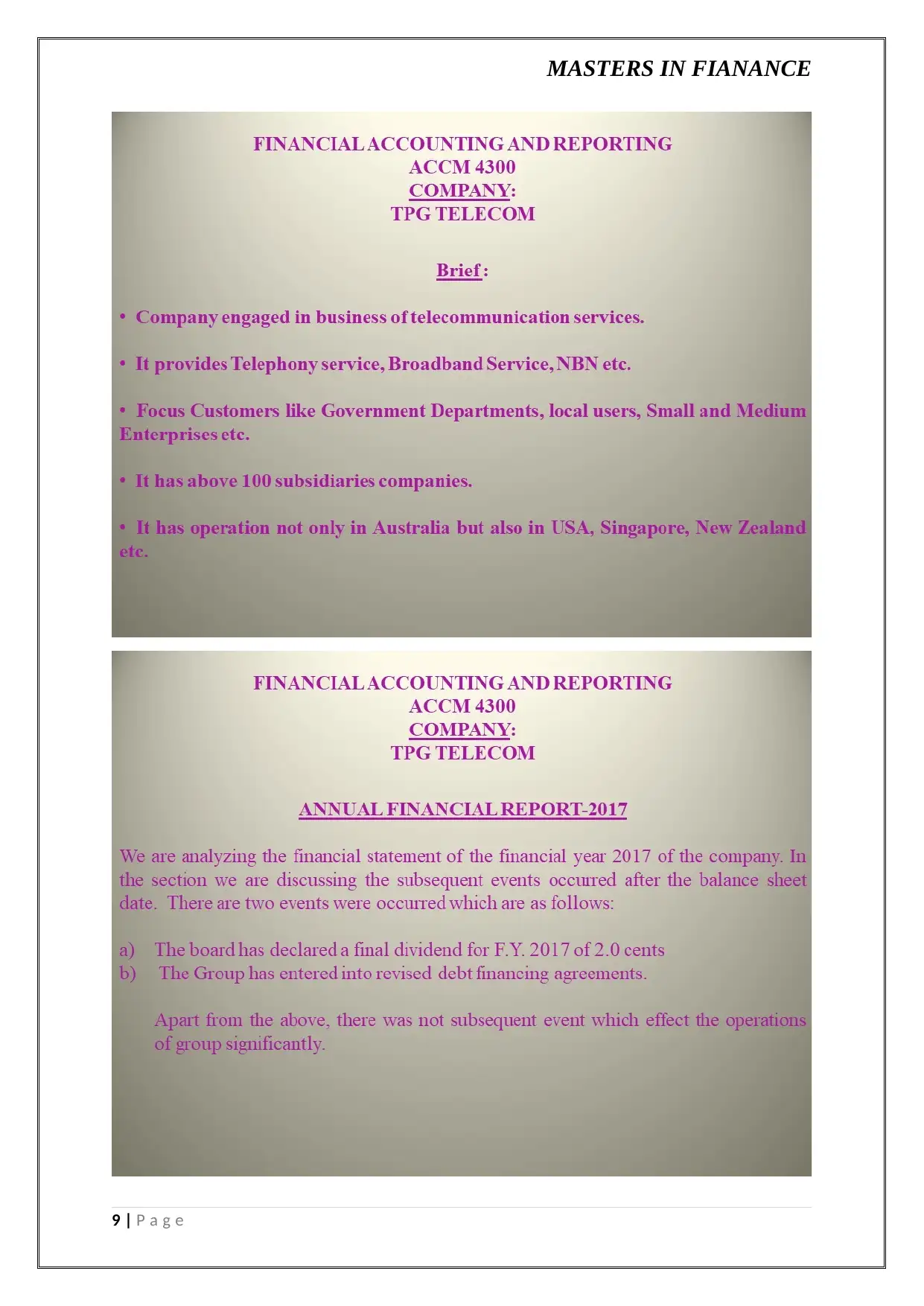
MASTERS IN FIANANCE
9 | P a g e
9 | P a g e
⊘ This is a preview!⊘
Do you want full access?
Subscribe today to unlock all pages.

Trusted by 1+ million students worldwide
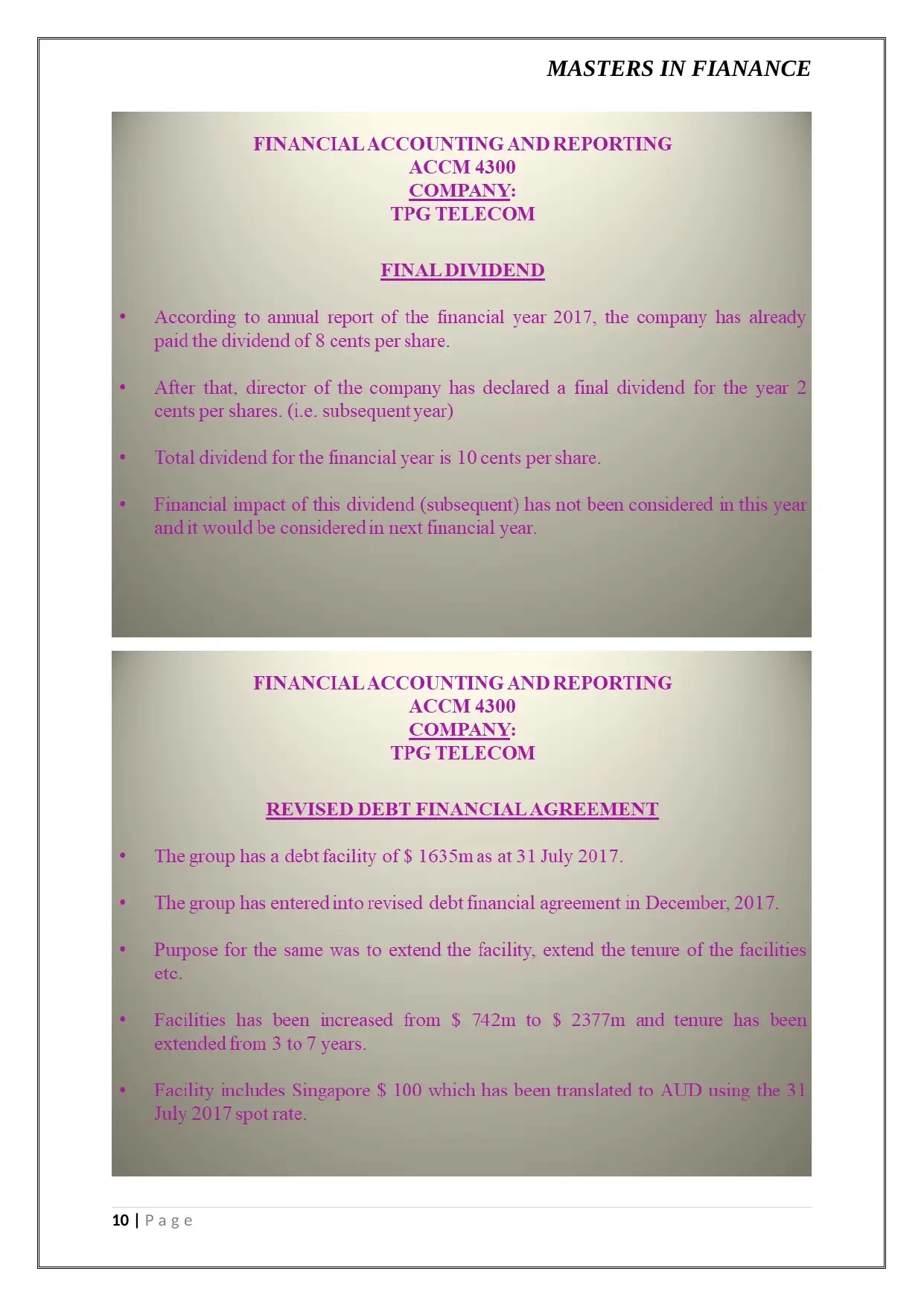
MASTERS IN FIANANCE
10 | P a g e
10 | P a g e
Paraphrase This Document
Need a fresh take? Get an instant paraphrase of this document with our AI Paraphraser
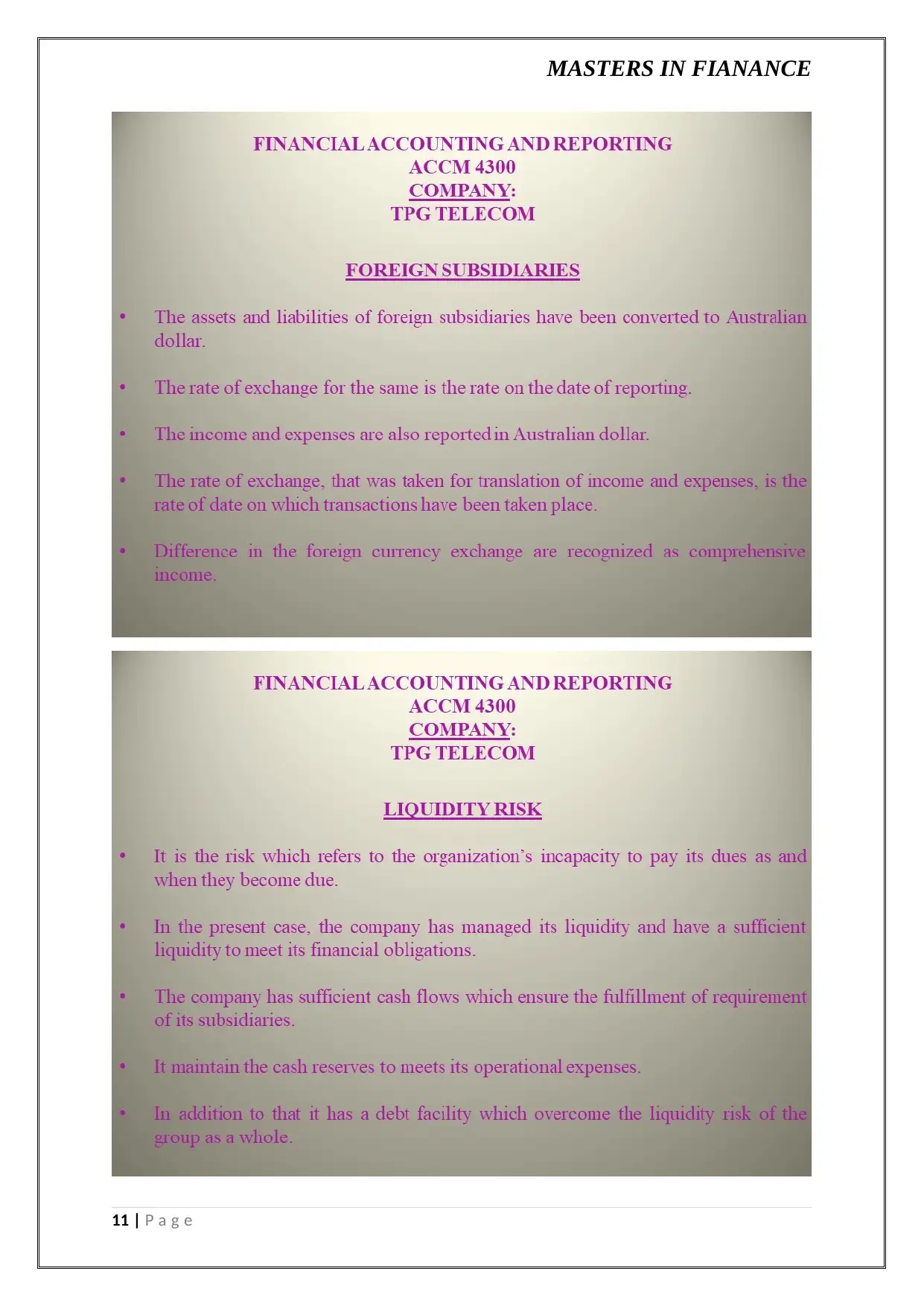
MASTERS IN FIANANCE
11 | P a g e
11 | P a g e
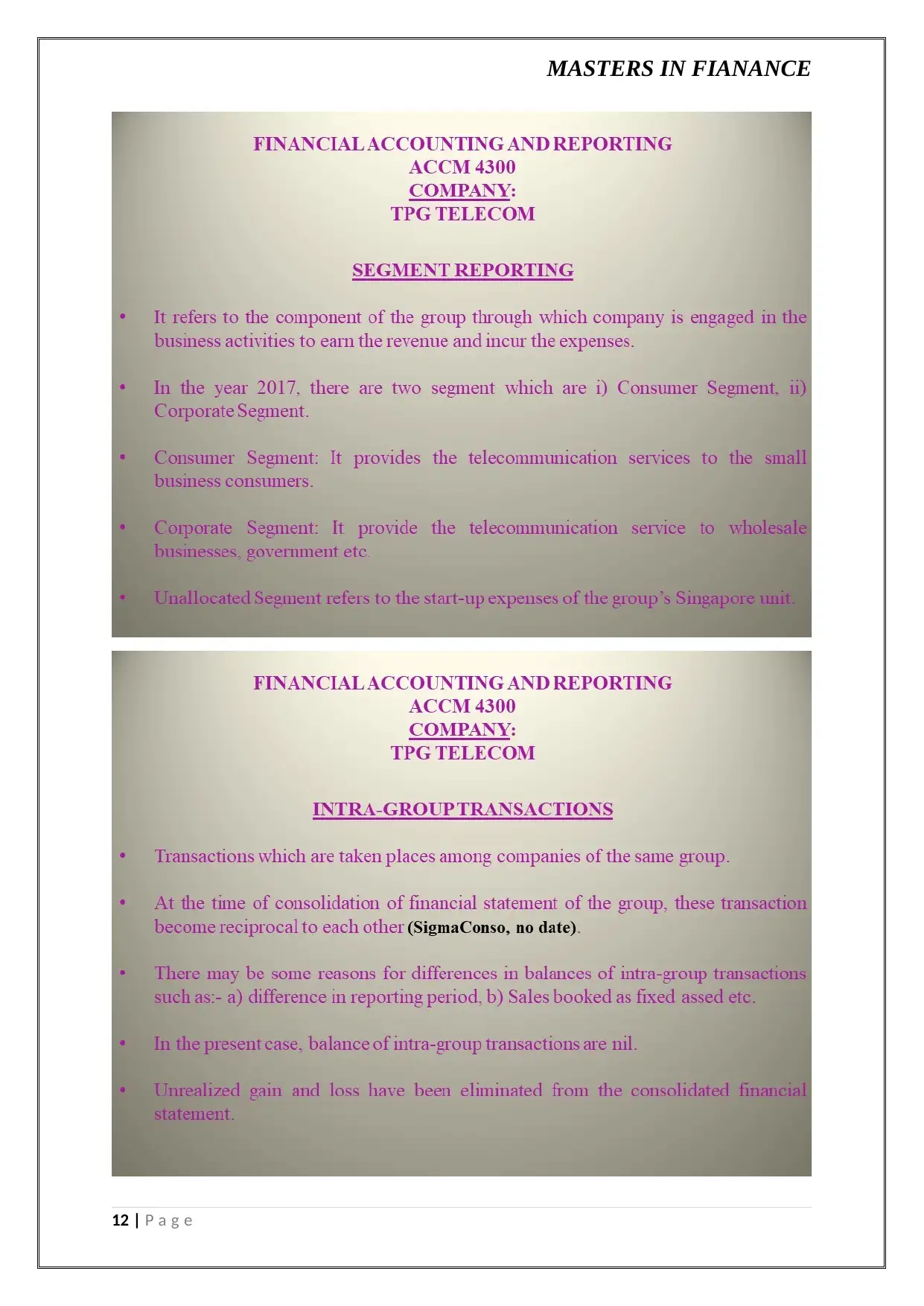
MASTERS IN FIANANCE
12 | P a g e
12 | P a g e
⊘ This is a preview!⊘
Do you want full access?
Subscribe today to unlock all pages.

Trusted by 1+ million students worldwide
1 out of 13
Related Documents
Your All-in-One AI-Powered Toolkit for Academic Success.
+13062052269
info@desklib.com
Available 24*7 on WhatsApp / Email
![[object Object]](/_next/static/media/star-bottom.7253800d.svg)
Unlock your academic potential
Copyright © 2020–2025 A2Z Services. All Rights Reserved. Developed and managed by ZUCOL.





